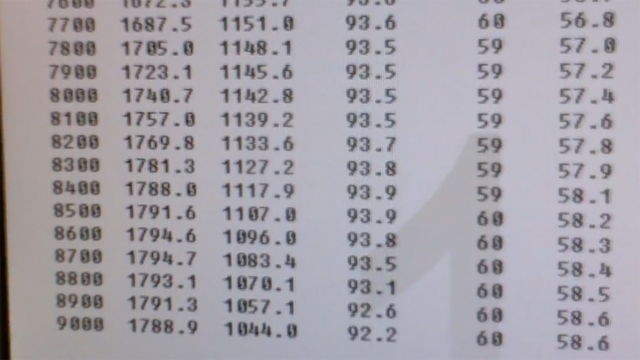EngineLabs recently posted a video of a killer Nissan VQ35 engine tuned by Shane Tecklenburg, a leading calibration expert with MoTec gear. Shane’s back with another Nissan engine, this time a RB26DETT for the same customer, Heat Treatments, Ltd. out of Auckland, New Zealand.
The RB26DETT engine is the inline six-cylinder engine that revived the third-generation Nissan Skyline GT-R and made it competitive on the world’s sportscar scene. The Heat Treatments team led by Keith McGregor has built one heck of a bullet, as it threw down nearly 1,800 horsepower on the dyno with Tecklenburg’s assistance.
As Tecklenburg notes, there are some differences when tuning a single-turbocharged engine such as this compared to the 3.5L V6 twin-turbo engine from the video referenced above.
“Things are very simple with a single. But with twins its not uncommon to have a variance in turbo speed due to small differences in the spring pressure in the wastegates. This is where things like my wastegate position sensors come in to play,” he explains. “When a twin turbo setup is run with a common intake plenum the manifold pressure is the average of what the two compressors output. But when one wastegate is open slightly more than another and because the wastegate is controlled by the manifold pressure which is an average, you wind up with the other compressor doing a bit more work. Since the work load is higher on the one with the gate closed the most, the exhaust pressure rises on that side of the engine only. That causes that bank of the engine to have a decrease in volumetric efficiency and if not corrected the air fuel ratio will be affected on that side of the engine. So it’s a matter of watching things as you progress through the operating range of the engine and boost control system and correcting these errors so that you can get the highest efficiency out of the components that have been selected.”
 Tecklenburg relies on a custom program written by himself and Injector Dynamics‘ Paul Yaw to develop a base volumetric efficiency signature of each engine prior to ever starting the tuning process. “I have a piece of software that I can enter some information into – which effect the amount of air the engine can move. Displacement, compression ratio, camshaft timing, minimum and maximum rpm and a few other things which I consider proprietary. What I am left with is a table which I can then import into the MoTeC ECU that is a graphical representation of the engine’s Volumetric Efficiency. I set up the MoTeC so that the table in fact represents true volumetric efficiency and then I run the engine and adjust the predefined curve to match reality,” he explains.
Tecklenburg relies on a custom program written by himself and Injector Dynamics‘ Paul Yaw to develop a base volumetric efficiency signature of each engine prior to ever starting the tuning process. “I have a piece of software that I can enter some information into – which effect the amount of air the engine can move. Displacement, compression ratio, camshaft timing, minimum and maximum rpm and a few other things which I consider proprietary. What I am left with is a table which I can then import into the MoTeC ECU that is a graphical representation of the engine’s Volumetric Efficiency. I set up the MoTeC so that the table in fact represents true volumetric efficiency and then I run the engine and adjust the predefined curve to match reality,” he explains.
This particular engine maxed out at 57 pounds of boost on the dyno for one reason – the MAP sensor employed on the dyno only reads to 58PSI.
The engine is based around the aforementioned RB26DETT architecture, and uses all top-shelf parts to achieve its power potential. A factory cylinder head, Bryant billet crankshaft, MGP aluminum connecting rods, JE forged pistons, LSM camshafts, and Ferrea valves handle the elevated boost levels admirably. An Aeromotive fuel pump and regulator is on board to meter the M1 fuel, and a dry sump oiling system to reach the horsepower potential.
The RB26 engine, as with the last one featured here tuned by Tecklenburg, uses a MoTec M800, MoTec’s CDI-8 ignition system, and Denso Iridium spark plugs. In an interesting departure, Suzuki Hayabusa coils are used to ensure that there is enough spark energy to light off the mixture.
Durability was at the forefront of this engine’s development, as the amount of boost pushed through the engine will quickly eat parts of they are not up to the task.
“Cylinder heads and wristpins are extremely important on something like this as are all the bits. They must be designed to withstand the loads they will encounter,” says engine builder McGregor. “I take extra special care to measure, and in some cases double measure to make sure things are at exact tolerances. A cylinder bore that is slightly out of perpendicular with the crank pin, for example, won’t make a lot of difference at 2 or maybe 300 horsepower but it puts a huge stress on things like the connecting rod and the wristpin and the rings when you run the power up into the thousands.”
The car shown above is boasted to be the world’s quickest Skyline. It’s driven by Reece McGregor and uses a Liberty air-shifted 5-speed transmission along with custom suspension including Koni coil overs at all four corners to control the chassis. So far the best pass on the car is a 7.57 at over 190MPH, but it looks like those times will be dropping the next time the car hits the track.

















